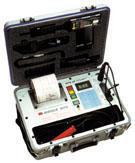 Research indicates that internal battery cell impedance increases with the age and discharge history of a cell. Since interruption in electrical service can spell disaster, a reliable backup power system is critical so that when conventional power fails, costly service outages can be avoided.
Research indicates that internal battery cell impedance increases with the age and discharge history of a cell. Since interruption in electrical service can spell disaster, a reliable backup power system is critical so that when conventional power fails, costly service outages can be avoided.
The BITE family of products provides meaningful data on battery health without significant expense or reduction in remaining battery capacity. The BITE products are designed for on-line ac impedance and dc terminal voltage measurement of secondary batteries.
The BITE 2 Battery Impedance Test Equipment determine the condition of lead-acid and nickel-cadmium cells up to 7000 Ah. An advanced feature set has been developed that includes Pass/Warning/Fail calculations based on a user-entered baseline value, advanced printing functions and more. The case of the BITE 2P consists of both the transmitter and a carrying case for all of the standard accessories and some of the optional accessories, in an all-in-one unit. The BITE 2 and its accessories fit into a sturdy canvas case with a shoulder strap.
The instruments work by applying a test current across the battery string while on-line, then measuring the total current (ac ripple + test current) and the voltage drop of each cell/jar. It then calculates the impedance. They also measure dc voltage and interconnection (strap) resistance to help determine the overall condition of the entire battery string’s electrical path from terminal plate to terminal plate.
The BITE 2 receiver stores the readings in its internal memory. These measurements, along with other maintenance data such as ambient and pilot cell temperatures and ac ripple current, assist in determining the overall condition of battery systems. Megger recommends that impedance measurements with the BITE 2 be made part of a battery maintenance program with readings taken and recorded semiannually for flooded batteries and quarterly for VRLA.
Unlike load cycle testing that involves substantial downtime and repeated discharges, using the instruments require no battery discharge, nor do they stress the battery in any way compared to other techniques. With a test time of less than 20 seconds for each cell and intercell connector, one person can easily, quickly, and precisely measure internal cell impedance, dc terminal voltage and intercell connection resistance without taking the battery system off line.
Latest posts by Mike Novello (see all)
- Used Bio-Rad Gel Doc XR For Sale - March 9, 2022
- CONSULTIX WTX-35-A4 CW Test Kit For Sale - November 9, 2021
- Biologic SP-150 Single Channel Potentiostat and VMP3B-80 Booster For Sale - September 7, 2021










